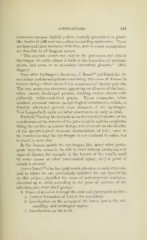Page 369 - My FlipBook
P. 369
ACTINOMYCOSIS. 341
numerous opaque, slightly yellow, coarsely granulated or gland-
like bodies of diiferent sizes, often resembling mulberries, Tbese
are here and there incrusted with lime, and on closer examination
are found to be of fungous nature.
" This mycosis occurs not only in the jaw-bones, but also in
the tongue of cattle, where it leads to the formation of erosions,
ulcers, and scars, or to secondary interstitial glossitis." (Bol-
linger.)
Soon after Bollinger's discovery, J. Israel^ published his ob-
serv^ations and investigations concerning two cases of disease in
human beings which showed the symptoms of chronic pyasmia.
The very numerous abscesses, appearing on all parts of the body,
when lanced, discharged profuse, stinking matter, strewn with
yellowish millet-seed-sized grains. These corpuscles, when
crushed, revealed various morphological constituents, which, as
Pontick afterward proved, were elements of the ray-fungus.
Von Langenbeck made a similar observation as early as 1845.
Pontick,^^ basing his deductions on the essential identity of the
constituents of the tumors of the jaws in cattle and the neoplasms
lining the cavities in human beings, but above all on the identity
of the morphological elements characteristic of both, came to
the conclusion that the ray-fungus is not confined to cattle, but
is found in man also.
In the human mouth the ray-fungus, like many other patho-
genic bacteria, seems to be able to exist without producing any
signs of disease, for example in the lacuna3 of the tonsils, until
by some means or other (mechanical injury, etc.) a point of
attack is created.
,^^
James Israel who has paid much attention to actinomycosis,
and to whom we are particularly indebted for our knowledge
on this subject, classified the cases of actinomycosis hominum,
observed up to 1885, according to the point of entrance of the
infection, into four chief groups :
1. Cases of invasion through the oral and pharyngeal cavities.
a. Central formation of foci in the mandibula.
b. Localization on the margin of the lower jaw in the sub-
maxillary and sublingual region.
c. Localization on the neck.


